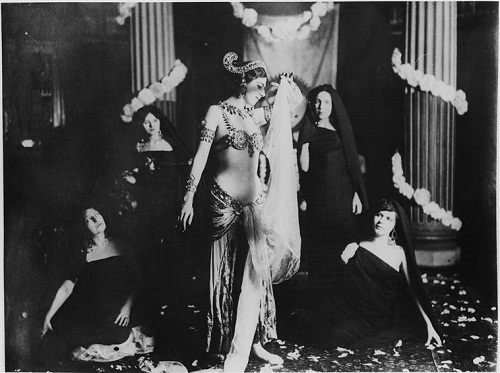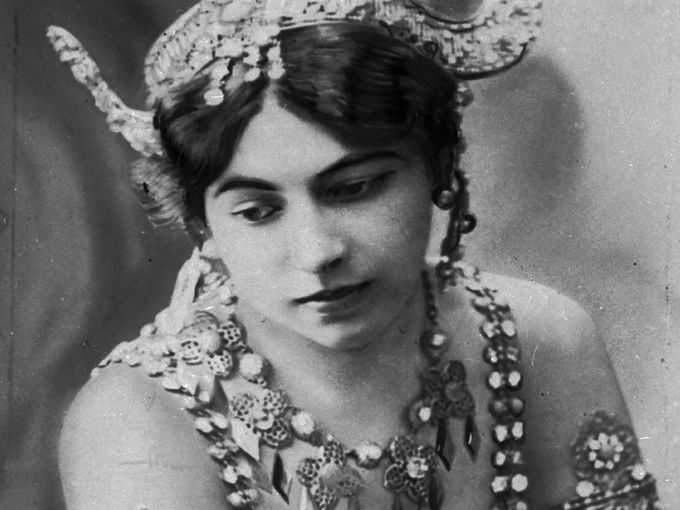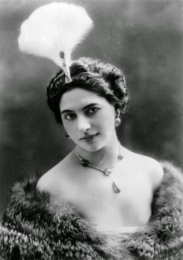
Promiscuous, flirtatious, and openly flaunting her body, she captivated her audience. This is Mata Hari…
Originally named Margaretha Geertruida “Grietje” Zelle MacLeod, her life spanned from first being a Dutch exotic dancer, to a courtesan, and finally an accused spy, that although possibly innocent, was executed by a firing squad in France for the German espionage during World War I.
Marta Hari was born in Leeuwarden, Friesland, in the Netherlands, as the eldest of Adam Zelle’s and Antje van der Meulen’s four children. She attended only exclusive schools, due to her father’s business success. However, Hari’s father went bankrupt in 1889, and the family got torn apart. The consequence for Mata was to move to her godfather, Heer Visser, in the little Dutch town Sneek.
At the age of eighteen, she answered an advertisement in a Dutch newspaper that was placed by a man looking for a wife. Marta Hari married Dutch colonial army officer Rudolf John MacLeod in Amsterdam on July 11, 1895. They moved to Java, located in the Dutch East Indies and got two children, named Norman-John and Jeanne-Louise.
The marriage was an overall disappointment. MacLeod turned out to be a violent alcoholic, who would take out his frustrations on his wife. He openly kept both, a native wife and a concubine. The disenchanted Marta abandoned him temporarily, and moved in with Van Rheedes, another Dutch officer. When she joined a local dance company, she intensively studied Indonesian traditions for months. After moving back to the Netherlands, the couple finally separated in 1902.

In 1903, she moved to Paris, where she performed as a circus horse rider under the name Lady MacLeod. Struggling to earn a living, she also posed as an artist’s model. By 1905, she began to win fame as an exotic dancer. It was then that she adopted the stage name Mata Hari. She became a leader of the early modern dance movement. Around the turn of the twentieth century, she looked to Asia and Egypt for artistic inspiration. Critics would later write about this and other such movements within the context of orientalism.
She experienced an overnight success from her debut act at the Musée Guimet on March 13, 1905 and became the longtime mistress of millionaire Lyon, industrialist Emile Etienne Guimet, who founded the Musée. She posed as a Java princess of priestly Hindu birth, pretending to have been immersed in the art of sacred Indian dance since childhood. She was photographed numerous times during this period, nude or nearly so.
She brought this carefree, provocative style to the stage in her act, which garnered wide acclaim. The most celebrated segment of her act was her progressive shedding of clothing until she would just wear a jeweled bra and some ornaments upon her arms and head.
Mata Hari was also a successful courtesan, though she was better known for her sensuality and eroticism, rather than for striking classical beauty. She had relationships with high-ranking military officers, politicians, and others in influential positions, from many countries. Her relationships and liaisons with powerful men frequently took her across international borders.
 Prior to World War I, she was generally viewed as an artist and a free-spirited bohemian; but as war approached, some began seeing her as a wanton and promiscuous woman, and perhaps a dangerous seductress.
Prior to World War I, she was generally viewed as an artist and a free-spirited bohemian; but as war approached, some began seeing her as a wanton and promiscuous woman, and perhaps a dangerous seductress.
During World War I, the Netherlands remained neutral. As a Dutch resident, Mata Hari was thus able to cross national borders freely. To avoid the battlefields, she traveled between France and the Netherlands via Spain and Britain, and her movements inevitably attracted attention.
On January 1917, the German military attaché in Madrid transmitted radio messages to Berlin, describing the helpful
activities of a German spy, code-named H-21. French intelligence agents intercepted the messages and, from the information they contained, identified H-21 as Mata Hari. On February 13, 1917, Mata Hari was arrested in her room at the Hotel Plaza Athénée in Paris. She was put on trial, accused of spying for Germany and consequently causing the death of at least fifty thousand soldiers. Although the French and British intelligence suspected her of spying for Germany, neither could produce definite evidence against her. At the age of 41, she was found guilty and executed by a firing squad on October 15, 1917.
The idea of an exotic dancer, who worked as a lethal double agent, while using her powers of seduction to extract military secrets from her many lovers, set the legend. It made Mata Hari an enduring archetype of the “femme fatale”.
 Discover Mata Hari’s entire story, as well as other “bombshells” in Fashion Industry Broadcast’s STYLE ICONS Vol. 3 “Bombshells”. Available on Amazon – worldwide.
Discover Mata Hari’s entire story, as well as other “bombshells” in Fashion Industry Broadcast’s STYLE ICONS Vol. 3 “Bombshells”. Available on Amazon – worldwide.







